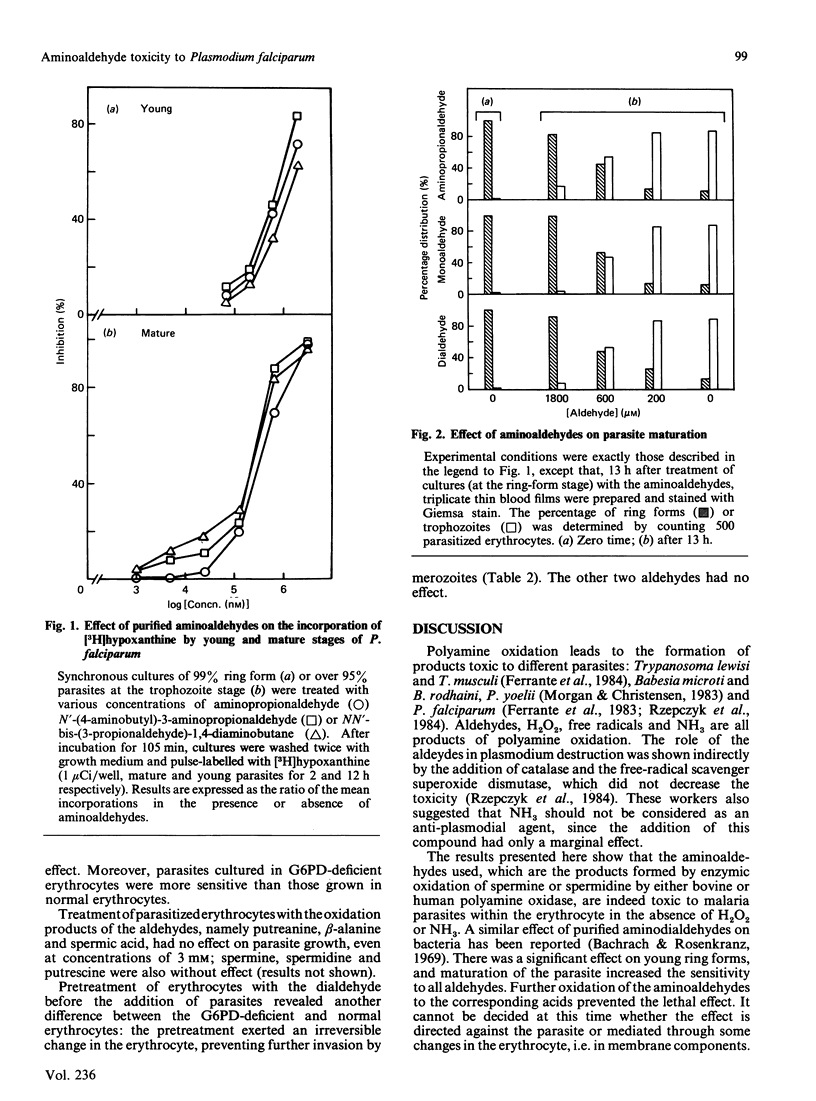Abstract
Purified aminoaldehydes produced by polyamine oxidation were toxic to the malarial parasite, Plasmodium falciparum, cultured in human erythrocytes. There was a profound effect on young ring forms, and, during maturation, parasites became more sensitive to the aldehydes. Oxidation of the aldehydes abolished the lethal effect. The plasmodia within glucose-6-phosphate-dehydrogenase (G6PD)-deficient erythrocytes were more sensitive to mono- and di-aldehydes than were parasites in normal erythrocytes. G6PD-deficient erythrocytes were also more sensitive to pretreatment with the dialdehyde produced by the oxidation of spermine. Pretreatment prevented further invasion by the parasites.
Full text
PDF




Selected References
These references are in PubMed. This may not be the complete list of references from this article.
- ALLISON A. C. Glucose-6-phosphate dehydrogenase deficiency in red blood cells of East Africans. Nature. 1960 May 14;186:531–532. doi: 10.1038/186531a0. [DOI] [PubMed] [Google Scholar]
- Allison A. C., Eugui E. M. The role of cell-mediated immune responses in resistance to malaria, with special reference to oxidant stress. Annu Rev Immunol. 1983;1:361–392. doi: 10.1146/annurev.iy.01.040183.002045. [DOI] [PubMed] [Google Scholar]
- Assaraf Y. G., Golenser J., Spira D. T., Bachrach U. Polyamine levels and the activity of their biosynthetic enzymes in human erythrocytes infected with the malarial parasite, Plasmodium falciparum. Biochem J. 1984 Sep 15;222(3):815–819. doi: 10.1042/bj2220815. [DOI] [PMC free article] [PubMed] [Google Scholar]
- Bachrach U. Metabolism and function of spermine and related polyamines. Annu Rev Microbiol. 1970;24:109–134. doi: 10.1146/annurev.mi.24.100170.000545. [DOI] [PubMed] [Google Scholar]
- Bachrach U., Reches B. Enzymic assay for spermine and spermidine. Anal Biochem. 1966 Oct;17(1):38–48. doi: 10.1016/0003-2697(66)90005-4. [DOI] [PubMed] [Google Scholar]
- Bachrach U., Rosenkranz H. S. Inhibition of bacterial macromolecular syntheses by the polyamine POX-3. Biochem Pharmacol. 1969 Jan;18(1):243–246. doi: 10.1016/0006-2952(69)90031-8. [DOI] [PubMed] [Google Scholar]
- DULBECCO R., VOGT M. Plaque formation and isolation of pure lines with poliomyelitis viruses. J Exp Med. 1954 Feb;99(2):167–182. doi: 10.1084/jem.99.2.167. [DOI] [PMC free article] [PubMed] [Google Scholar]
- Ferrante A., Rzepczyk C. M., Allison A. C. Polyamine oxidase mediates intra-erythrocytic death of Plasmodium falciparum. Trans R Soc Trop Med Hyg. 1983;77(6):789–791. doi: 10.1016/0035-9203(83)90290-0. [DOI] [PubMed] [Google Scholar]
- Ferrante A., Rzepczyk C. M., Saul A. J. Polyamine oxidase-mediated trypanosome killing: the role of hydrogen peroxide and aldehydes. J Immunol. 1984 Oct;133(4):2157–2162. [PubMed] [Google Scholar]
- Golenser J., Miller J., Spira D. T., Navok T., Chevion M. Inhibitory effect of a fava bean component on the in vitro development of Plasmodium falciparum in normal and glucose-6-phosphate dehydrogenase deficient erythrocytes. Blood. 1983 Mar;61(3):507–510. [PubMed] [Google Scholar]
- Jensen J. B., Boland M. T., Hayes M., Akood M. A. Plasmodium falciparum: rapid assay for in vitro inhibition due to human serum from residents of malarious areas. Exp Parasitol. 1982 Dec;54(3):416–424. doi: 10.1016/0014-4894(82)90051-0. [DOI] [PubMed] [Google Scholar]
- Jensen J. B. Concentration from continuous culture of erythrocytes infected with trophozoites and schizonts of Plasmodium falciparum. Am J Trop Med Hyg. 1978 Nov;27(6):1274–1276. doi: 10.4269/ajtmh.1978.27.1274. [DOI] [PubMed] [Google Scholar]
- Kimes B. W., Morris D. R. Preparation and stability of oxidized polyamines. Biochim Biophys Acta. 1971 Jan 1;228(1):223–234. doi: 10.1016/0005-2787(71)90562-4. [DOI] [PubMed] [Google Scholar]
- Lambros C., Vanderberg J. P. Synchronization of Plasmodium falciparum erythrocytic stages in culture. J Parasitol. 1979 Jun;65(3):418–420. [PubMed] [Google Scholar]
- MOTULSKY A. G. Metabolic polymorphisms and the role of infectious diseases in human evolution. Hum Biol. 1960 Feb;32:28–62. [PubMed] [Google Scholar]
- Miller J., Golenser J., Spira D. T., Kosower N. S. Plasmodium falciparum: thiol status and growth in normal and glucose-6-phosphate dehydrogenase deficient human erythrocytes. Exp Parasitol. 1984 Jun;57(3):239–247. doi: 10.1016/0014-4894(84)90097-3. [DOI] [PubMed] [Google Scholar]
- Morgan D. M. Polyamine oxidases. Biochem Soc Trans. 1985 Apr;13(2):322–326. doi: 10.1042/bst0130322. [DOI] [PubMed] [Google Scholar]
- Pasvol G., Wilson R. J. The interaction of malaria parasites with red blood cells. Br Med Bull. 1982 May;38(2):133–140. doi: 10.1093/oxfordjournals.bmb.a071749. [DOI] [PubMed] [Google Scholar]
- Rzepczyk C. M., Saul A. J., Ferrante A. Polyamine oxidase-mediated intraerythrocytic killing of Plasmodium falciparum: evidence against the role of reactive oxygen metabolites. Infect Immun. 1984 Jan;43(1):238–244. doi: 10.1128/iai.43.1.238-244.1984. [DOI] [PMC free article] [PubMed] [Google Scholar]
- TABOR C. W., TABOR H., BACHRACH U. IDENTIFICATION OF THE AMINOALDEHYDES PRODUCED BY THE OXIDATION OF SPERMINE AND SPERMIDINE WITH PURIFIED PLASMA AMINE OXIDASE. J Biol Chem. 1964 Jul;239:2194–2203. [PubMed] [Google Scholar]
- TABOR C. W., TABOR H., ROSENTHAL S. M. Purification of amine oxidase from beef plasma. J Biol Chem. 1954 Jun;208(2):645–661. [PubMed] [Google Scholar]
- Trager W., Jensen J. B. Human malaria parasites in continuous culture. Science. 1976 Aug 20;193(4254):673–675. doi: 10.1126/science.781840. [DOI] [PubMed] [Google Scholar]


